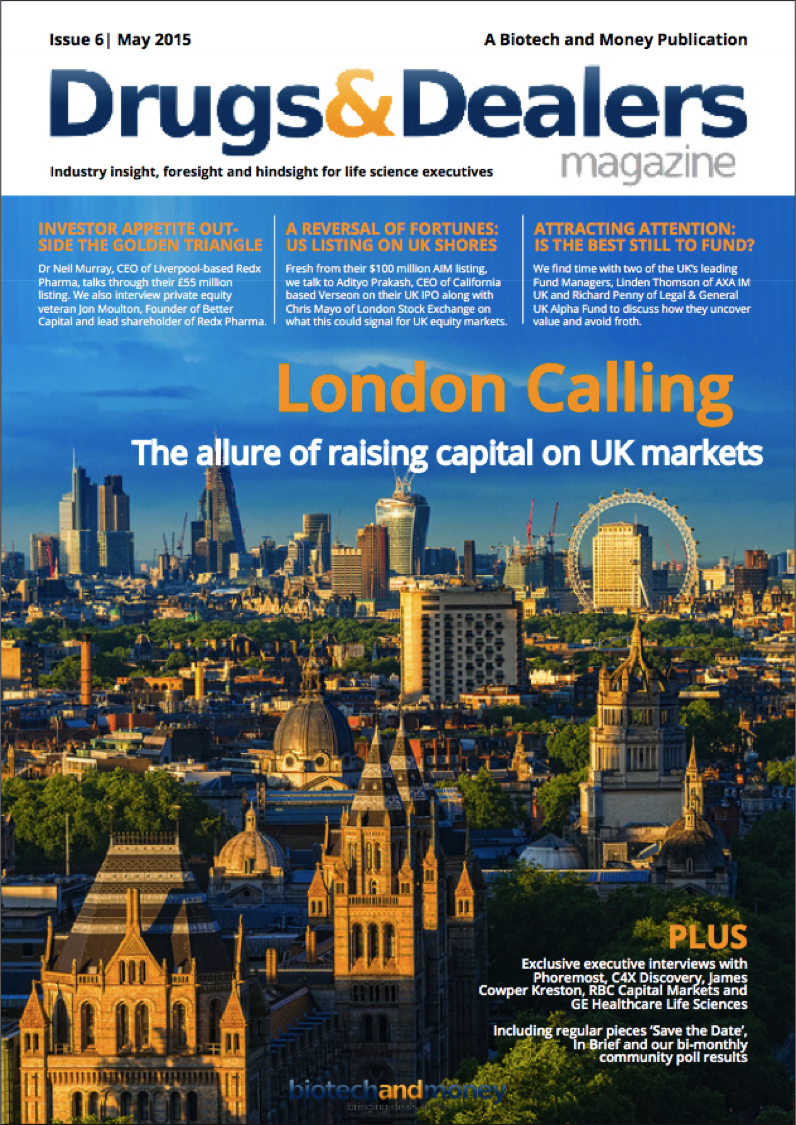Presenting scientific leadership and a clear focus
Shaun Grady, VP, BD Operations, Astrazeneca. Shaun is responsible for broadening AstraZeneca’s access to scientific innovation outside their own laboratories. Including in-licencing, acquisition and partnering activities from early stage Discovery through to on-market commercial opportunities.
B&M: Shaun, can you expand upon what your role entails? What are your roles and responsibilities within AstraZeneca and where you do spend the bulk of your energy?
SG: We split our business development activities broadly into two; the first being strategy, search and evaluation, and the second transaction execution (due diligence, negotiation of deals and then increasingly importantly integration and the alliance management of projects that have been completed). I’m responsible for that second area.
I’ve got a group of about 35 or so people fitting broadly into those three segments of due diligence directors, transaction leadership (people who actually head up the deals) and finally the alliance and integration management people who ensure that smooth transition of the partnership or acquisitions from their prior ownership to the AstraZeneca group or contractual relationship.
B&M: And within your remit what would you say are your key priorities for the coming year?
SG: Put simply the BD priority is to use acquisition and partnering to further our strategic intention in three core therapy areas: oncology, cardiovascular and metabolic disease, and finally respiratory, inflammation and autoimmune disease.
B&M: How has the strategic review, with its stated priorities of re-establishing scientific leadership and a return to growth, impacted the BD strategy?
SG: From the strategic review, we developed focused and clear target initiatives, which have been our aide memoire as we have pursued business development opportunities over the last 18 months.
B&M: What trends do you see happening across big pharma in terms of how business development is being conducted in this day and age?
SG: I think people generally are being much clearer on the areas they are focusing on and the areas that they are setting out their stall to win in. I think we can see that from the sort of TA (therapy area) swap-type transactions that have taken place earlier this year, most notably between Novartis and GSK and Lilly and that sort of triangulation of assets. Whereas before I think we were all a bit more open minded and agnostic as to the therapy areas that we looked to do BD in as we sought to leverage our commercial footprint and sales and marketing capability around the world. Clearly in our case, and broadly true across the sector, people are now much more focused on areas where they think they’ve got scientific leadership and are putting their internal resources, their deal dollars and deal buying power, into those prioritised areas.
B&M: Where do you see that going in terms of the future? Do you think that trend will be exacerbated?
SG: I don’t know about exacerbations, but we’ve set out our stall and we’re pleased at the progress that we’ve made in terms of the pipeline and on-market portfolio. Business development played a critical role in that because of some of the deals that we’ve done, most notably strengthening our respiratory franchise, including the recent acquisition of Almirall’s respiratory business. This has made a really strong contribution to increasing the strength of the pipeline in respiratory and also bringing some immediate revenues.
B&M: Okay, so just a last question on the strategic review. Would you say you are on the way to achieving those objectives or is there still a lot of ground to be covered?
SG: We’re a long way from declaring victory, but we’re pretty pleased with the business development we’ve done and overall progress that we’ve made. Business development has played a role in that but of course it’s not singularly business development; we’ve made a huge amount of progress with quite a significant number of programmes in our organic pipeline, beating expectations in terms of data delivery.
B&M: We are witnessing a general tendency of pharma doing deals earlier, and entering into collaborations at a much earlier stage. What do you think are the fundamental drivers of this trend?
SG: Personally I think it is a clear trend. Secondly it’s a trend we’reparticipating in and cultivating. I think there are two things. If you look at companies like ours experiencing the so-called patent expiry stage, it’s only naturally to be expected that companies with that business shape would look at later stage projects because they deliver short term revenues to try and mitigate those lost revenues. Hence if you look at AstraZeneca’s deal sheet over the last two to four years, there’s a lot of later stage business development activity. But of course the closer you get to your patent expiries and when you’re in the midst of it, there is less impact that you can make by doing very late stage deals.
The second thing is if you have a strategic goal of re-establishing your scientific leadership, it follows quite naturally that you’d be looking to bring really creative break-throughs and high science into your organisation. You do that in part by doing earlier business development. That brings with it a number of different aspects such as it being clearly higher risk. You might say it’s less costly to do business development earlier because you’ve got that risk. The third driver that we subscribe to is if you do your business development earlier, you’ve got longer to spend with your partner bringing AstraZeneca’s skills and capabilities to bear on the programme for longer, rather than, say, buying a phase 3 ready programme where really all the thinking and all the science has been done and everybody is just waiting to see what the data read-out is from phase 3.
B&M: So you clearly see the trend as a positive one and one that is a force for good? What do you think the implications are for the industry as a whole for this trend?
SG: I think it can only be good. I think people that have got good science are doing a good job of making that clear to prospective partners and purchasers, like AstraZeneca.
People talk periodically about it being a buyers’ market in biotech business development. I’m not sure I agree with that when people have got really exciting break-through science, they tend to make sure they attract all the key big players to the table. It’s a fairly competitive process usually. And I think with the relaxation of the public markets towards biotech, particularly in the US, I think smaller biotech companies with exciting technologies have also not got the alternative of a more organic growth and independent route if that’s the track they want to go down.
B&M: Let’s turn to peer collaborations at the moment. How do you think peer collaborations can be finessed to get mutually beneficial outcomes and what do you think are the key success factors of these collaborations?
SG: That’s a great question, and peer collaborations are an area where we feel that we’ve got some relevant experience, particularly from our collaboration with Bristol-Myers Squibb. People talk a lot in business development about creative deal making and putting innovative transactions together, and I think personally speaking we apply that label a little too liberally and freely sometimes, but making a 7 billion dollar joint acquisition of a biotech company that we and Bristol-Myers Squibb did was extremely innovative, creative and something that nobody has replicated in healthcare before or since. What we’re trying to do is take the learning and experience we have developed from the Bristol-Myers Squibb peer partnership and factor it into subsequent partnerships, such as the one we’ve put in place with Amgen around inflammation assets.
B&M: If you could distil some of those success factors from the Bristol partnership, what do you think those would be? What were the key learnings?
SG: I think the key learning that we’ve all come to terms with is the need to have confidence in your partner. When we first put the partnership together we felt that we had to do everything in two’s like Noah’s ark syndrome. In every country we both had marketing people, we both had commercial directors, we both had patient safety people which of course if you multiply that across many geographies and many different functions, could potentially lead to a lot of inefficiency. So the thing that we’ve learnt is the need to have confidence in your partner that you can actually give up particular activities or maybe particular geographies.
B&M: So it comes to down to trust?
SG: That mutual trust means that actually you don’t need to put one of your own in to keep an eye on what the other guy is doing and vice versa. You really should be impartial as to who does what, and be motivated by getting the most capable people who can do what is necessary most effectively rather than feeling that you need to have some form of man-marking approach which is a little bit how we thought about it back in 2006/2007.
B&M: All pharma companies would like to be considered to be the partner of choice. So I wondered what you think AstraZeneca’s USP is? How do you differentiate yourself as a prospective partner?
SG: I do think we differentiate ourselves, and I would say that wouldn’t I! But we spent quite a bit of time a couple of years ago thinking about how we look from the outside from a partnering perspective. We even went to the trouble of putting together an advisory board, about a dozen people, VC’s and private equity, law firms and biotech and we held the mirror up on how we behaved and what we did. The message we got then was actually there was a real opportunity to differentiate ourselves, and that nobody really stood out from the pharma peer group. What was surprising was that the feedback on things that make a difference were really quite straight forward, deliverable and common sense, in terms of responsiveness to enquiries, speed of response, and quality of feedback. In essence we foster a peer-peer relationship and interaction with prospective partners rather than an arrogant approach from big pharma. We set ourselves targets in terms of response times, turnaround times, and quality of feedback and the like. We underwent something of a culture change internally about prioritising people approaching us from the outside, and you can follow that change of approach and mentality to quite a striking improvement in Astrazeneca’s ratings in the various partnering surveys that take place from time to time.
So that would be the first thing. And I think the second thing that differentiates us and has become even more so under Pascal’s leadership is the speed in which we can do deals and execute on deals. I think we’re as good as anyone in a foot race, which is often the case if people have really high-quality science that they’re looking to partner on a competitive basis. We have created a governance and decision-making climate within Astrazeneca such that we can move very quickly.
Shaun’s interview was recently featured in January’s Drugs & Dealers Magazine, the official online publication of Biotech and Money. Providing industry insight, foresight and hindsight for Life Science executives. Download the full Magazine here.





Leave a comment